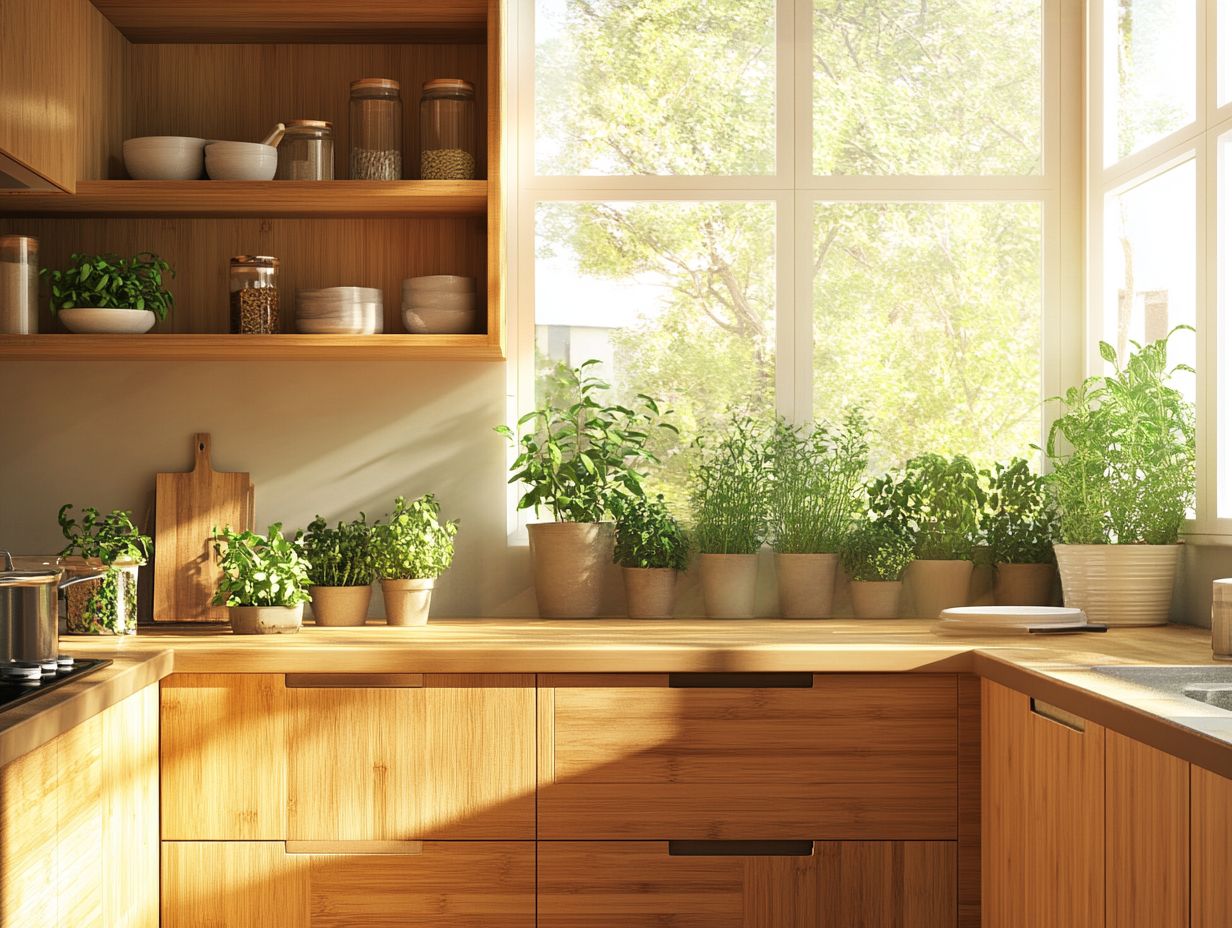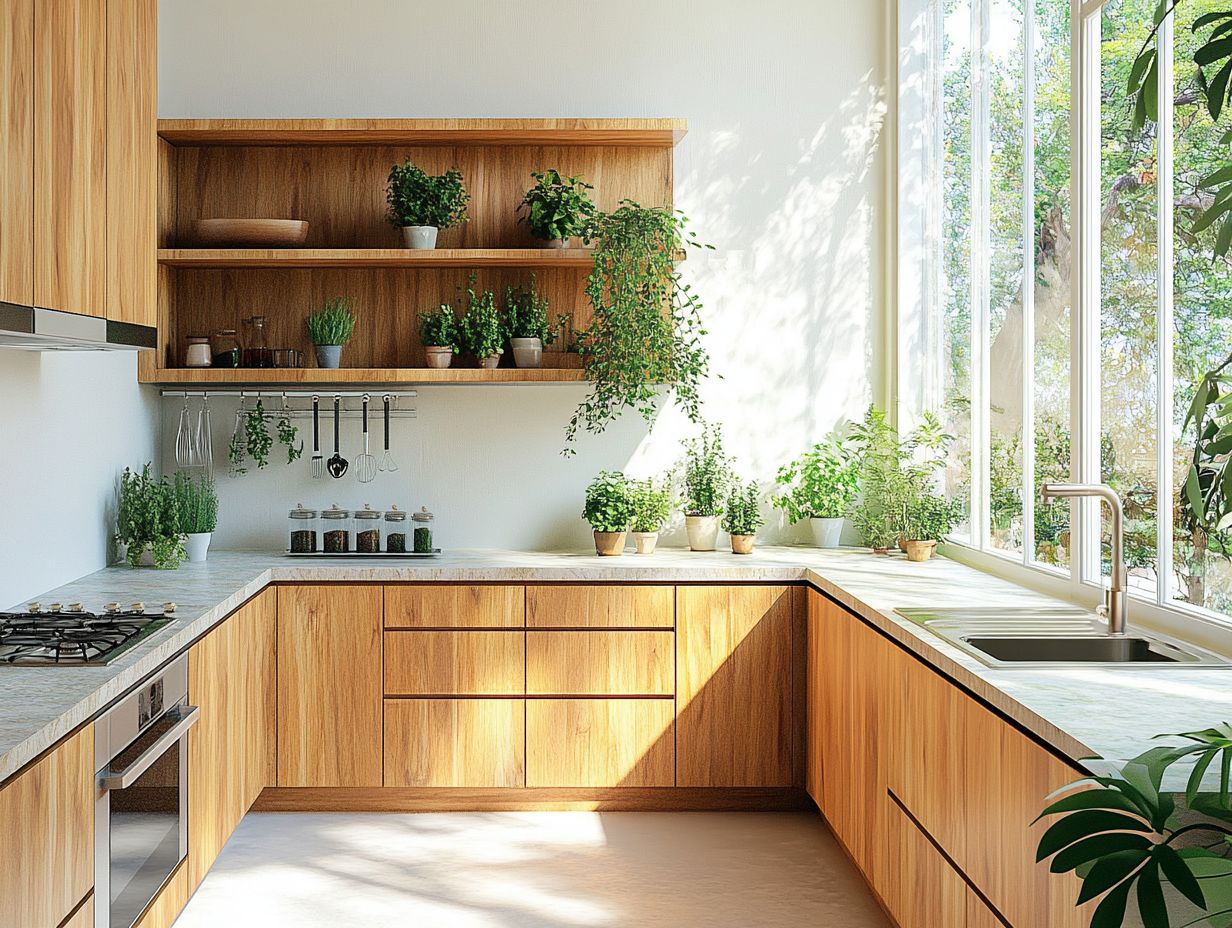Understanding Kitchen Material Sustainability
In today’s world, the concept of sustainability has woven itself into every facet of life, including your kitchen.
Kitchen material sustainability focuses on selecting eco-friendly materials that reduce environmental impact while enhancing health and safety. This article explores what kitchen material sustainability truly means, its importance for both the planet and your well-being, the various sustainable materials available to you, and practical tips for incorporating these options into your kitchen design.
Start your journey toward creating a greener, healthier kitchen today!
Contents
- Key Takeaways:
- What is Kitchen Material Sustainability?
- Why is Kitchen Material Sustainability Important?
- Eco-Friendly Kitchen Materials
- Factors to Consider When Choosing Sustainable Kitchen Materials
- How to Incorporate Sustainable Materials in Your Kitchen
- Frequently Asked Questions
- What is kitchen material sustainability?
- Why is understanding kitchen material sustainability important?
- How does using sustainable kitchen materials benefit the environment?
- What are some examples of sustainable kitchen materials?
- Are sustainable kitchen materials more expensive?
- Can I still have a stylish kitchen while using sustainable materials?
Key Takeaways:

Kitchen material sustainability refers to the use of eco-friendly and non-toxic materials in kitchen design and renovation. Understanding the importance of sustainable kitchen materials is key to reducing environmental impact and promoting health and safety in the home. Factors such as cost, durability, and maintenance should be considered when choosing sustainable materials for your kitchen. There are numerous tips for incorporating these materials into your design for a greener kitchen.
What is Kitchen Material Sustainability?
Kitchen material sustainability entails selecting materials and products for your kitchen design that significantly reduce environmental impact while prioritizing health and safety.
By emphasizing eco-friendly options like bamboo, recycled glass, and energy-efficient appliances, you can create a sustainable kitchen that reflects your commitment to environmentally conscious living.
You should minimize harmful substances and enhance indoor air quality by choosing materials such as low-VOC paints, which are safer for indoor air quality, and durable, non-toxic finishes.
Defining the Concept
To define kitchen material sustainability, grasp the delicate balance between functionality and environmental impact. It stresses the importance of adopting eco-friendly practices during renovation and design.
This concept also emphasizes the significance of using renewable resources that help preserve the planet’s natural reserves. By selecting materials certified by organizations such as the Forest Stewardship Council, you ensure that your choices are responsibly harvested, fostering forest conservation and promoting biodiversity.
Making environmentally responsible choices not only contributes to sustainability but also enhances the kitchen’s aesthetics. You can blend natural beauty with modern design, creating a space that is both stylish and functional while significantly reducing your ecological footprint.
Why is Kitchen Material Sustainability Important?
The significance of kitchen material sustainability is profound, influencing both the environment and human health.
By embracing eco-friendly practices, you can minimize harmful substances and create a healthier living space, enhancing not only your kitchen but also your overall well-being.
Environmental Impact of Kitchen Materials

The environmental impact of kitchen materials spans their entire lifecycle, from extraction and processing to disposal and recycling, underscoring the importance of sustainable choices.
When you choose materials like sustainably sourced wood or recycled metal, you can significantly ease the burden on our planet’s natural resources. The extraction of traditional materials often results in habitat destruction and increased carbon emissions. In contrast, eco-friendly practices, such as using renewable resources, help to alleviate these detrimental effects.
Incorporating recycled materials not only conserves energy and raw materials but also reduces pollution. By embracing sustainable options, you can create a kitchen that performs beautifully while positively contributing to the environment, paving the way for a greener future for generations to come.
Take the first step towards sustainable living by making eco-friendly choices in your kitchen today!
Health and Safety Concerns
Health and safety concerns in your kitchen largely stem from exposure to harmful substances. Reducing chemicals that can harm air quality is a vital consideration when selecting eco-friendly materials for your kitchen design.
Many traditional kitchen materials emit toxic fumes that can seriously compromise indoor air quality. Certain paints, adhesives, and finishes often contain harmful chemicals, which can provoke allergic reactions and respiratory issues.
Choosing low chemical paints and water-based finishes is crucial; these options greatly reduce harmful emissions in your home.
By opting for non-toxic choices, you create a healthier kitchen for you and your loved ones! This proactive approach minimizes the risk of exposure to allergens and irritants, safeguarding everyone’s health in this essential space.
Eco-Friendly Kitchen Materials
Eco-friendly kitchen materials include a variety of sustainably sourced and recycled options that lower your environmental impact while providing durability and aesthetic charm.
Types of Sustainable Materials
When considering sustainable materials, you’ll find delightful options like bamboo, cork, and recycled glass. Each brings its unique blend of beauty and eco-friendliness.
Bamboo offers warm tones and a natural grain. It’s incredibly durable and grows quickly, making it a fantastic choice for cabinetry and countertops while combating deforestation.
Cork, harvested from the bark of cork oak trees, provides a soft, resilient surface that’s naturally antimicrobial. It’s perfect for flooring and wall panels, enhancing comfort and health in the kitchen.
Recycled glass countertops come in vibrant colors and designs. They reduce waste by repurposing discarded materials, improving your kitchen’s aesthetics and promoting energy efficiency.
Incorporating these materials not only enhances your kitchen’s beauty but also helps minimize your environmental footprint and embrace a sustainable lifestyle.
Factors to Consider When Choosing Sustainable Kitchen Materials

When selecting sustainable kitchen materials, consider key factors like cost, durability, and maintenance. This thoughtful approach helps create a kitchen design that is both practical and eco-friendly.
Cost, Durability, and Maintenance
Cost, durability, and maintenance are essential factors when choosing eco-friendly materials for your kitchen remodel; these elements directly impact sustainability and functionality.
As you weigh these considerations, remember their interconnectedness. Durable materials may require a higher upfront investment, but the long-term savings on repairs and replacements can be significant.
Opting for materials that need less upkeep not only saves you time but also limits the use of harsh chemicals, aligning with environmentally friendly practices.
Low-maintenance choices can enhance your kitchen’s appeal, ensuring it remains stylish and practical—a welcoming space for your daily activities.
How to Incorporate Sustainable Materials in Your Kitchen
Incorporating sustainable materials into your kitchen requires a thoughtful design approach that highlights eco-friendly practices. This commitment enhances both the functionality and aesthetics of your green kitchen remodel.
Tips for a Greener Kitchen
To create a greener kitchen, consider embracing a range of thoughtful strategies. You can easily start by selecting sustainable materials, utilizing energy-efficient appliances, and adopting eco-friendly practices. These steps can elevate your kitchen design to new heights.
One practical step is to choose low VOC (volatile organic compounds) paints for your cabinets and walls. VOCs are harmful chemicals found in some paints, and using low VOC options will significantly improve the air quality in your home. Investing in durable materials, such as stainless steel kitchenware, is another smart move. Not only does it stand the test of time, but it can also be recycled when its life cycle ends.
For maintaining surfaces naturally, think about using finishes made from natural oils and beeswax. These options enhance durability without introducing harmful chemicals into your space.
Incorporate compost bins to reduce food waste dramatically. Growing herbs on your windowsill adds both greenery and fresh flavors to your culinary creations.
Frequently Asked Questions

What is kitchen material sustainability?
Kitchen material sustainability refers to using eco-friendly and durable materials in kitchen design and construction. The goal is to reduce environmental impact and promote longevity.
Why is understanding kitchen material sustainability important?
Understanding kitchen material sustainability is crucial because it allows individuals to make informed choices about the materials they use in their kitchen. This promotes sustainability and reduces the negative impact on the environment.
How does using sustainable kitchen materials benefit the environment?
Using sustainable kitchen materials benefits the environment in several ways:
- Reduces the need for deforestation
- Conserves natural resources
- Decreases the amount of waste sent to landfills
- Promotes healthier indoor air quality
- Reduces the carbon footprint of a kitchen
What are some examples of sustainable kitchen materials?
Examples of sustainable kitchen materials include:
- Bamboo
- Recycled glass
- Reclaimed wood
- Salvaged or repurposed materials
These materials are environmentally friendly and can be used in various aspects of kitchen design.
Are sustainable kitchen materials more expensive?
In general, sustainable kitchen materials may be slightly more expensive than traditional materials. However, the long-term benefits of using these materials—such as reduced energy costs and improved durability—often outweigh the initial cost.
Can I still have a stylish kitchen while using sustainable materials?
Absolutely! There are many stylish and trendy options for sustainable kitchen materials, such as bamboo flooring or recycled glass countertops. With the growing demand for eco-friendly options, a wide range of aesthetically pleasing sustainable materials is available on the market.
Start transforming your kitchen today for a greener tomorrow!





